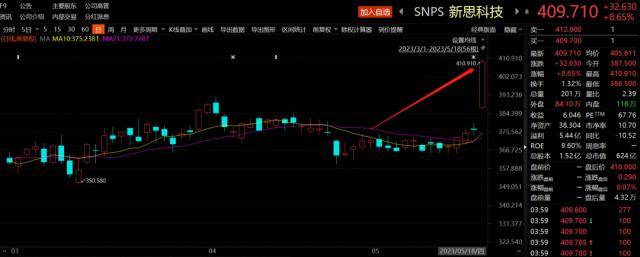Home >Technology peripherals >AI >This EDA US stock hits a record high. Has the logic of AI 'feeding back' semiconductors been established?
This EDA US stock hits a record high. Has the logic of AI 'feeding back' semiconductors been established?
- WBOYWBOYWBOYWBOYWBOYWBOYWBOYWBOYWBOYWBOYWBOYWBOYWBforward
- 2023-05-26 18:25:321026browse
NVIDIA calls chip manufacturing an "ideal application" for AI computing. AMD has begun to apply AI in the chip design, testing and verification stages, and Rapidus will also introduce AI.
GPU and other chips have become the core of the "AI boom". They control the development direction of AI technology and continuously promote its upgrading. At the same time, the development of AI has also begun to feed back into chip manufacturing.
On Thursday local time, Synopsys’ U.S. stocks jumped 8.65% after opening higher, setting a record high .
The company announced its second-quarter results and third-quarter expectations after the U.S. stock market closed on Wednesday, both of which were higher than analysts’ expectations. The company attributed ’s business growth to artificial intelligence and automation-the company launched it in April The industry's first full-stack AI-driven EDA solution Synopsys.ai, which covers the design, verification, testing and manufacturing of advanced digital and analog chips.

It is worth noting that many companies in the industry have mentioned the application of AI in chip manufacturing this week.
NVIDIA founder and CEO Jensen Huang recently emphasized the potential of NVIDIA's accelerated computing and AI solutions in chip manufacturing. He believes that chip manufacturing is an "ideal application" for accelerated computing and AI computing .
Mark Papermaster, Chief Technology Officer of AMD, another chip giant, also revealed that AMD has begun to apply AI in the semiconductor design, testing and verification stages, and plans to use generative methods more extensively in the field of chip design in the future. AI. At the same time, AMD is already experimenting with GitHub Copilot (developed by GitHub and OpenAI) and studying how to better deploy this AI assistant.
Japanese semiconductor company Rapidus President Junyi Koike said that will introduce artificial intelligence and automation technology and establish a mass production process with about 500 technical personnel. The company already has the talent, equipment, and technology in place and is expected to start mass production in 2027.
In advanced chip manufacturing, more than 1,000 steps must be experienced. Each stage required complex calculations, and each step had to be nearly perfect. Even in a semiconductor downcycle, chip companies generally prefer to continue investing in their own R&D programs.
This gives AI a "place to use".
AI excels in chip design, allowing for infinite iterations until the best solution is found. More than that, while iterating, AI will also learn. It will study which mode can create the optimal design. Therefore, AI actually speeds up the speed of chip design optimization layout, and brings higher performance and lower energy consumption.
In the verification and testing process, AI can also maximize test coverage and save time.
As for whether AI will take away the "jobs" of chip R&D engineers? The answer given by AMD Chief Technology Officer Papermaster is no. He believes that AI will not replace chip designers. It will serve as an auxiliary tool and has great potential to help accelerate design. Source: Science and Technology Innovation Board Daily
The above is the detailed content of This EDA US stock hits a record high. Has the logic of AI 'feeding back' semiconductors been established?. For more information, please follow other related articles on the PHP Chinese website!
Related articles
See more- Technology trends to watch in 2023
- How Artificial Intelligence is Bringing New Everyday Work to Data Center Teams
- Can artificial intelligence or automation solve the problem of low energy efficiency in buildings?
- OpenAI co-founder interviewed by Huang Renxun: GPT-4's reasoning capabilities have not yet reached expectations
- Microsoft's Bing surpasses Google in search traffic thanks to OpenAI technology

